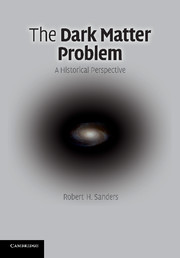Book contents
- Frontmatter
- Contents
- Acknowledgements
- 1 Introduction
- 2 Early history of the dark matter hypothesis
- 3 The stability of disk galaxies: the dark-halo solution
- 4 Direct evidence: extended rotation curves of spiral galaxies
- 5 The maximum-disk: light traces mass
- 6 Cosmology and the birth of astroparticle physics
- 7 Clusters revisited: missing mass found
- 8 CDM confronts galaxy rotation curves
- 9 The new cosmology: introducing dark energy
- 10 An alternative to dark matter: modified Newtonian dynamics
- 11 Seeing dark matter: the theory and practice of detection
- 12 Reflections: a personal point of view
- Appendix Astronomy made simple
- References
- Index
9 - The new cosmology: introducing dark energy
Published online by Cambridge University Press: 05 July 2014
- Frontmatter
- Contents
- Acknowledgements
- 1 Introduction
- 2 Early history of the dark matter hypothesis
- 3 The stability of disk galaxies: the dark-halo solution
- 4 Direct evidence: extended rotation curves of spiral galaxies
- 5 The maximum-disk: light traces mass
- 6 Cosmology and the birth of astroparticle physics
- 7 Clusters revisited: missing mass found
- 8 CDM confronts galaxy rotation curves
- 9 The new cosmology: introducing dark energy
- 10 An alternative to dark matter: modified Newtonian dynamics
- 11 Seeing dark matter: the theory and practice of detection
- 12 Reflections: a personal point of view
- Appendix Astronomy made simple
- References
- Index
Summary
The accelerated expansion of the Universe
In November of 1054, Chinese court astronomer, Yang Wei-te, reported to the Emperor on the appearance of a new star in the Hyades star cluster. He was, no doubt, apprehensive because unpredicted celestial events were a considerable occupational hazard for astronomers of that time and place and could lead to an abrupt and permanent termination of all contracts. What the Chinese astronomers had seen was a supernova within the Milky Way Galaxy; this particular example produced one of the most astrophysically interesting objects in the Galaxy – the Crab nebula and its embedded pulsar.
Supernovae are among the most dramatic and violent events in the Universe. A single star explodes and, for a period of time, outshines an entire galaxy. In recorded human history there are several such occurrences in the nearby Milky Way, Tycho's (1572) and Kepler's (1604) being examples observed and recorded by Europeans after the emergence of that continent from the Dark Ages.
From an observational point of view, there are clearly two types of supernovae – creatively called type I and type II. In both types, a star suddenly brightens by many orders of magnitude and then fades over several weeks. The two types are clearly distinguishable, not only by their light curves but also by their spectra: type I have none of the characteristic lines of hydrogen that are evidenced by type II.
- Type
- Chapter
- Information
- The Dark Matter ProblemA Historical Perspective, pp. 119 - 131Publisher: Cambridge University PressPrint publication year: 2010



